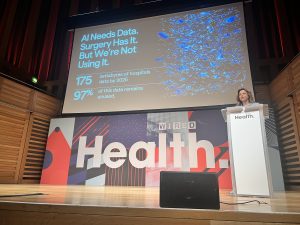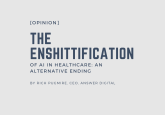WIRED Health 2025: AI’s Potential Role in the Operating Room

The annual WIRED Health event promises to deliver the most exciting updates to the healthcare world, and this year was no exception. On the 18th of March 2025, leading experts in the field –scientists, doctors, and entrepreneurs alike– came together from across the globe to the city of London (UK) with one united goal: to spark discussions on the rapidly changing healthcare landscape.
The High Price of Surgery in Healthcare
One of the day’s highlights was a talk delivered by Dr Nadine Hachach-Haram, a consultant plastic surgeon and CEO of Proximie. She considered the pitfalls of operating rooms—especially in the UK— and how her company Proximie is utilizing AI to overcome these.
Surgery is one of the most expensive aspects of the NHS, with operating theatres costing around £1200 per hour to run.
What’s more, efficiency is low—in fact, a recent report from the Centre for Perioperative Care found that around 135,000 surgical cancellations are made on the day, racking up an estimated £400 million of lost operating theatre time.
Another survey from the Royal College of Surgeons revealed an average of ~14,000 hospital beds were taken up each day by patients deemed medically fit during just one week in February 2025. With 4.4 million people each year in the UK needing surgery, this is a critical area of the NHS that could greatly benefit from reform.
Operating Rooms: What Happens Behind Closed Doors?
While some data exists on the topic, Nadine opens the discussion by pointing out significant gaps in surgical research. For example, one recent report highlights that there is currently no national collection of data on operating theatre processes—e.g., time spent in surgery, personnel involved, and time spent in recovery. This lack of information has left experts puzzled with how best to cut back on wasted time and money:
“The operating room is incredibly opaque,” says Nadine. “It’s an analog environment—75% of the operating room’s activities remain undocumented.”
She further describes surgical theatres as a “white space”—a vast untapped reserve of potential that, if transformed into connected and intelligent environments, could greatly improve patient outcomes.
Critical Healthcare Data is Collecting Dust
At a pivotal point in the digital health era, AI is uniquely poised to uncover the root causes of surgical inefficiencies. By analyzing large datasets, machine learning could pick out complex patterns that humans might otherwise miss.
Hospitals represent invaluable sources of information that could unlock this potential, with healthcare data making up 30% of all the data in the world and growing faster than any other data type.
However, Nadine notes that a shocking 97% of health data remains unused, expanding the “white space” analogy of operating rooms to a broader picture of the world’s health systems.

She stresses the need for more intelligent data use with a somber fact:
“About 4.2 million people are dying around the world within 30 days of surgery—half of these deaths are avoidable.”
She continues: “It’s preventable if we can actually capture and understand why this is happening. We need real-time insights; intelligence in the moment.”
Reinventing Surgery with AI
Proximie is hoping to tackle this challenge by digitizing the operating theatre, offering a unified platform that connects surgeons with real-time data insights and analytics.
The technology offer some core functions:
- Physicians can remotely view live or recorded surgical footage, supporting the training of new surgeons and allowing experienced practitioners to refine their skills.
- Access to live expertise during procedures, enabling surgeons to seek second opinions while operating and potentially avoid medical errors.
- AI-powered data analysis of the operating room, identifying areas of concern and helping healthcare professionals to cut back inefficiencies.
Nadine stresses the success of Proximie so far in US healthcare: “By analyzing over 700 hours of video footage and 10,000 data points, we were able to show that hospitals were running at about 24% inefficiency within the operating room.”
She enforces that, by adding an extra three cases a week, Proximie showed to surgical departments that they could accommodate an additional 9000 procedures per year, generating an additional $90 million in the US.
Nadine now hopes to bring the same data-driven strategies to the UK health system.
She concludes:
“This isn’t just the beginning. This is the future of the intelligent operating rooms. Do we continue tolerating these inefficiencies, or do we change? And the choice is clear: let’s choose innovation.”





